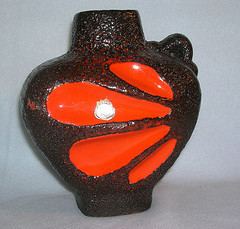 | ||
West German Art Pottery or Fat Lava refers to the ceramics produced in West German Studios from the early 1950s until reunification of East and West Germany in 1990.
Contents
History
After the defeat of Nazi Germany, it took a few years to rebuild the German pottery industry. During its heyday from the 1950s until the 1970s, over 100 pottery and porcelain companies and studio potters were actively producing art pottery in West Germany. Scheurich, Carstens, Bay, ES, and Dümler & Breiden were the most prolific producers, and while production began slowing in the early 1970's, a wide variety of art pottery was produced well in the 1980s.
West German Art Pottery is well-known for its great variety of forms and expressive colors. Since the 2000s, ceramic collectors West German Art Pottery has become increasingly collectible, and the first books on the subject were published. Simultaneously, some major collections were put on display. However, a great deal remains undocumented, and some of the early research had significant errors. Attributions continue to be corrected, so information should be checked to make sure it's up to date.
Fat Lava
The terms Fat Lava and West German Art Pottery are often used interchangeably, but technically have a different meaning. Fat Lava refers specifically to a type of thick glazes that gives the object a thick lava-like look. This type of glaze was commonly used in this period by German pottery manufacturers. The term Fat Lava itself though is of a much more recent date. It has been suggested that the term Fat Lava first emerged with an exhibition curated by Dr. Graham Cooley during the King's Lynn Arts Festival in 2006, but the term was actually being used by sellers in Germany at least a decade earlier and may actually be due to a slightly faulty computer translation that came up with "fat" when the more accurate term would be "thick". The precise origin is likely to remain uncertain, but it definitely predates the fat lava exhibition and related catalog.
